ECU FIAT FULLBACK 2018 Owner handbook (in English)
[x] Cancel search | Manufacturer: FIAT, Model Year: 2018, Model line: FULLBACK, Model: FIAT FULLBACK 2018Pages: 316, PDF Size: 10.52 MB
Page 8 of 316
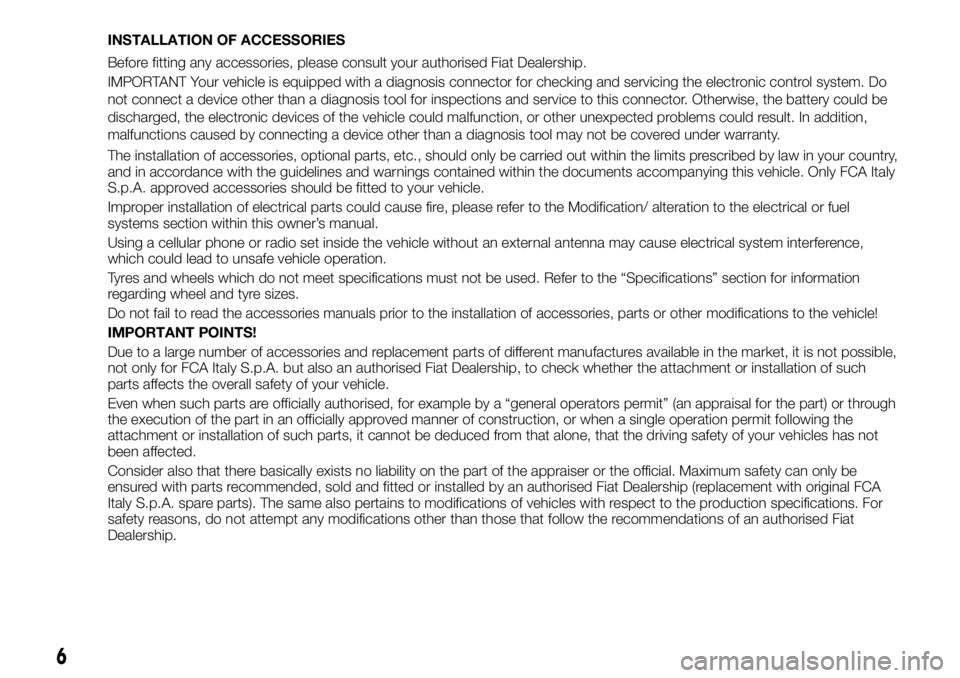
INSTALLATION OF ACCESSORIES
Before fitting any accessories, please consult your authorised Fiat Dealership.
IMPORTANT Your vehicle is equipped with a diagnosis connector for checking and servicing the electronic control system. Do
not connect a device other than a diagnosis tool for inspections and service to this connector. Otherwise, the battery could be
discharged, the electronic devices of the vehicle could malfunction, or other unexpected problems could result. In addition,
malfunctions caused by connecting a device other than a diagnosis tool may not be covered under warranty.
The installation of accessories, optional parts, etc., should only be carried out within the limits prescribed by law in your country,
and in accordance with the guidelines and warnings contained within the documents accompanying this vehicle. Only FCA Italy
S.p.A. approved accessories should be fitted to your vehicle.
Improper installation of electrical parts could cause fire, please refer to the Modification/ alteration to the electrical or fuel
systems section within this owner’s manual.
Using a cellular phone or radio set inside the vehicle without an external antenna may cause electrical system interference,
which could lead to unsafe vehicle operation.
Tyres and wheels which do not meet specifications must not be used. Refer to the “Specifications” section for information
regarding wheel and tyre sizes.
Do not fail to read the accessories manuals prior to the installation of accessories, parts or other modifications to the vehicle!
IMPORTANT POINTS!
Due to a large number of accessories and replacement parts of different manufactures available in the market, it is not possible,
not only for FCA Italy S.p.A. but also an authorised Fiat Dealership, to check whether the attachment or installation of such
parts affects the overall safety of your vehicle.
Even when such parts are officially authorised, for example by a “general operators permit” (an appraisal for the part) or through
the execution of the part in an officially approved manner of construction, or when a single operation permit following the
attachment or installation of such parts, it cannot be deduced from that alone, that the driving safety of your vehicles has not
been affected.
Consider also that there basically exists no liability on the part of the appraiser or the official. Maximum safety can only be
ensured with parts recommended, sold and fitted or installed by an authorised Fiat Dealership (replacement with original FCA
Italy S.p.A. spare parts). The same also pertains to modifications of vehicles with respect to the production specifications. For
safety reasons, do not attempt any modifications other than those that follow the recommendations of an authorised Fiat
Dealership.
6
Page 33 of 316
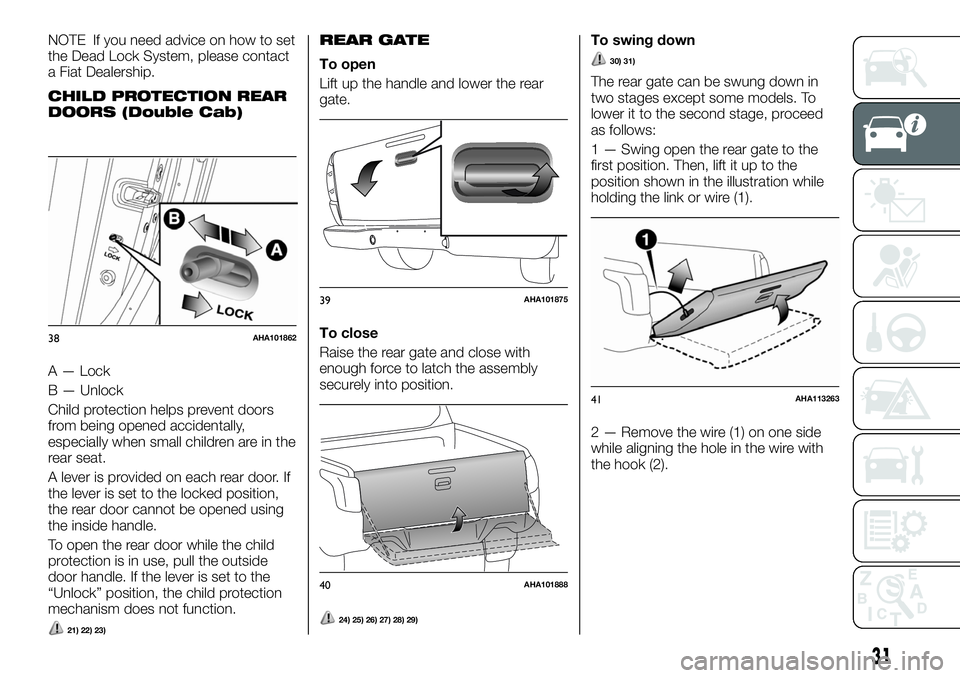
NOTE If you need advice on how to set
the Dead Lock System, please contact
a Fiat Dealership.
CHILD PROTECTION REAR
DOORS (Double Cab)
A — Lock
B — Unlock
Child protection helps prevent doors
from being opened accidentally,
especially when small children are in the
rear seat.
A lever is provided on each rear door. If
the lever is set to the locked position,
the rear door cannot be opened using
the inside handle.
To open the rear door while the child
protection is in use, pull the outside
door handle. If the lever is set to the
“Unlock” position, the child protection
mechanism does not function.
21) 22) 23)
REAR GATE
To open
Lift up the handle and lower the rear
gate.
To close
Raise the rear gate and close with
enough force to latch the assembly
securely into position.
24) 25) 26) 27) 28) 29)
To swing down
30) 31)
The rear gate can be swung down in
two stages except some models. To
lower it to the second stage, proceed
as follows:
1 — Swing open the rear gate to the
first position. Then, lift it up to the
position shown in the illustration while
holding the link or wire (1).
2 — Remove the wire (1) on one side
while aligning the hole in the wire with
the hook (2).
38AHA101862
39AHA101875
40AHA101888
41AHA113263
31
Page 34 of 316

3 — Remove the wire on the other side
in the same manner, and have the rear
gate swing down slowly.
WARNING
11)Make sure the doors are closed:
driving with doors not completely closed is
dangerous.12)NEVER leave children unattended
inside the car, let alone leave the car with
the doors unlocked in a place that children
can access easily. Children may seriously,
or even fatally, injure themselves. Also
ensure that children do not inadvertently
operate
13)Be careful not to lock the doors while
the key is inside the vehicle.
14)When opening the rear door, confirm
that the occupant of the front seat has
taken off the seat belt before opening the
rear door. If you open the rear door with
the front seat belt being worn, the
occupant of the front seat may be
tightened with the locked seat belt and
could result in serious injury.
15)When closing the rear door, make sure
not being trapped your hands or your
fingers in the doors.
16)Before driving, make sure that the rear
door is securely closed. If a door is ajar, the
door ajar warning lamp will illuminates. If a
door is not completely closed, the rear
door could open while driving and this
could cause an accident such as
occupants being thrown from the vehicle.
17)When opening or closing the rear door,
please observe the followings. If you do not
follow them, it could result in damage to
your vehicle. Do not open or close the rear
door and the front door at the same time.
18)Do not open or close the rear door
when the front door is not completely
opened.
19)Do not close the rear door after closing
the front door.20)When the vehicle-speed sensitive
automatic door lock/Impact-sensitive
unlock mechanism may not operate in the
following conditions, have the vehicle
inspected at a Fiat Dealership immediately.
1– The door does not lock automatically
even when the vehicle speed exceeds
approximately 15 km/h. 2 — The door
unlocks automatically while driving. 3 —
Even when the ignition switch or the
operation mode is in ON, the SRS warning
lamp does not come on or it remains on. 4
— The SRS warning lamp comes on while
driving. 5 — The central door lock system
is broken down.
21)When driving with a child in the rear
seat, please use the child protection to
prevent accidental door opening which
may cause an accident.
22)If the child lock was engaged and the
previously described locking procedure
carried out, operating the internal opening
handle will not open the door: in this case,
to open the door, the outside handle must
be used. The door central locking/
unlocking button is not disabled by the
engagement of the emergency lock.
23)Always use this device when carrying
children. After engaging the child lock on
both rear doors, check for effective
engagement by trying to open a door with
the internal handle.
24)Do not stand behind the exhaust pipe
when loading and unloading luggage. Heat
from the exhaust could lead to burns.
25)Pay attention not to catch your fingers
in the rear gate.
26)Do not weight the rear gate.
42AHA113276
43AHA112934
32
GETTING TO KNOW YOUR VEHICLE
Page 35 of 316
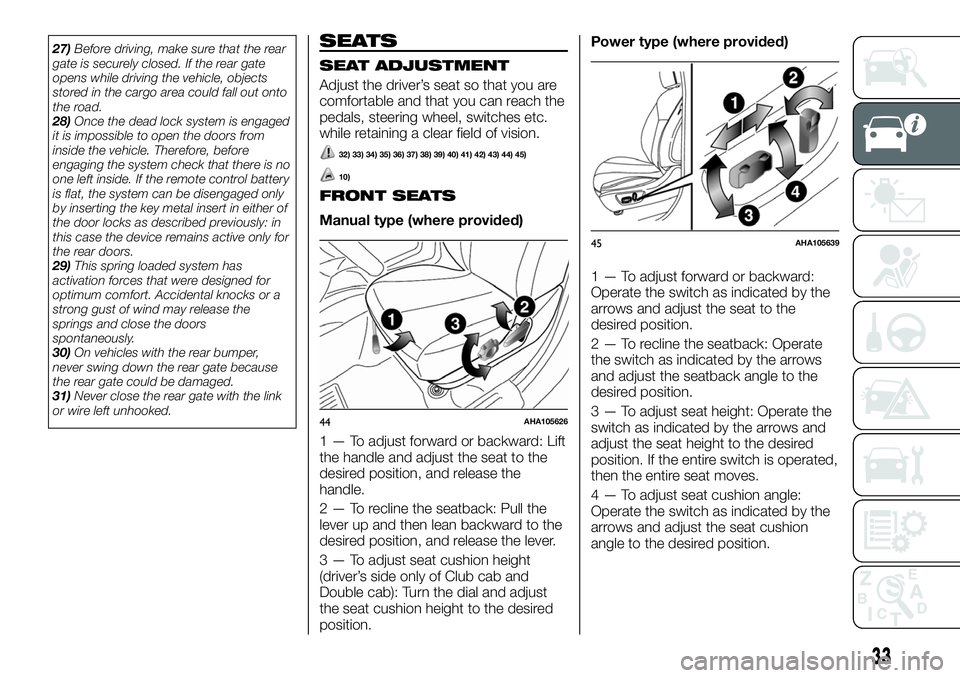
27)Before driving, make sure that the rear
gate is securely closed. If the rear gate
opens while driving the vehicle, objects
stored in the cargo area could fall out onto
the road.
28)Once the dead lock system is engaged
it is impossible to open the doors from
inside the vehicle. Therefore, before
engaging the system check that there is no
one left inside. If the remote control battery
is flat, the system can be disengaged only
by inserting the key metal insert in either of
the door locks as described previously: in
this case the device remains active only for
the rear doors.
29)This spring loaded system has
activation forces that were designed for
optimum comfort. Accidental knocks or a
strong gust of wind may release the
springs and close the doors
spontaneously.
30)On vehicles with the rear bumper,
never swing down the rear gate because
the rear gate could be damaged.
31)Never close the rear gate with the link
or wire left unhooked.SEATS
SEAT ADJUSTMENT
Adjust the driver’s seat so that you are
comfortable and that you can reach the
pedals, steering wheel, switches etc.
while retaining a clear field of vision.
32) 33) 34) 35) 36) 37) 38) 39) 40) 41) 42) 43) 44) 45)
10)
FRONT SEATS
Manual type (where provided)
1 — To adjust forward or backward: Lift
the handle and adjust the seat to the
desired position, and release the
handle.
2 — To recline the seatback: Pull the
lever up and then lean backward to the
desired position, and release the lever.
3 — To adjust seat cushion height
(driver’s side only of Club cab and
Double cab): Turn the dial and adjust
the seat cushion height to the desired
position.Power type (where provided)
1 — To adjust forward or backward:
Operate the switch as indicated by the
arrows and adjust the seat to the
desired position.
2 — To recline the seatback: Operate
the switch as indicated by the arrows
and adjust the seatback angle to the
desired position.
3 — To adjust seat height: Operate the
switch as indicated by the arrows and
adjust the seat height to the desired
position. If the entire switch is operated,
then the entire seat moves.
4 — To adjust seat cushion angle:
Operate the switch as indicated by the
arrows and adjust the seat cushion
angle to the desired position.
44AHA105626
45AHA105639
33
Page 36 of 316
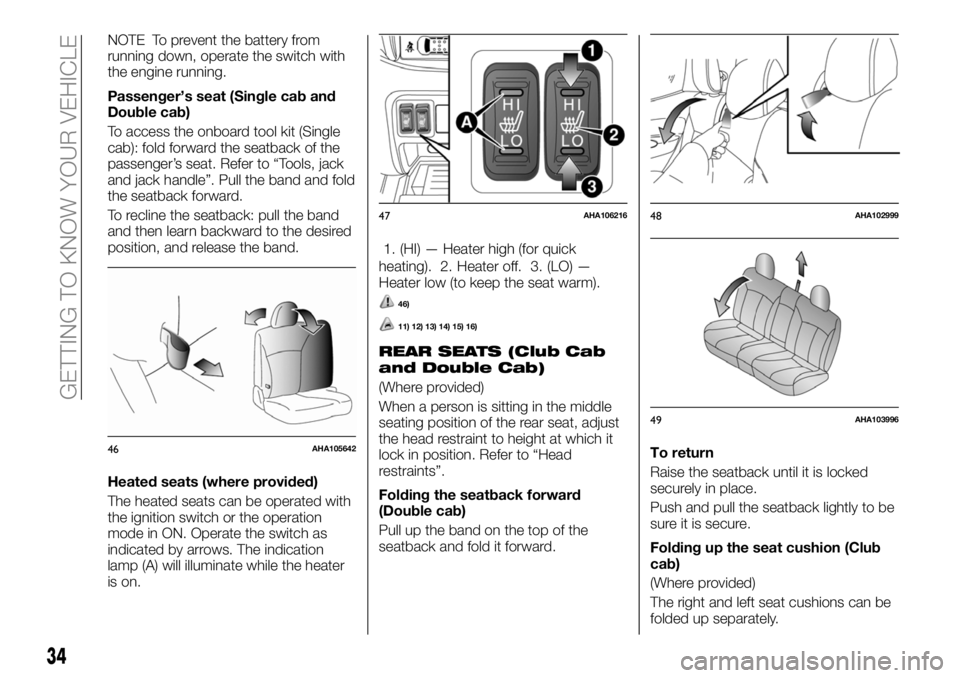
NOTE To prevent the battery from
running down, operate the switch with
the engine running.
Passenger’s seat (Single cab and
Double cab)
To access the onboard tool kit (Single
cab): fold forward the seatback of the
passenger’s seat. Refer to “Tools, jack
and jack handle”. Pull the band and fold
the seatback forward.
To recline the seatback: pull the band
and then learn backward to the desired
position, and release the band.
Heated seats (where provided)
The heated seats can be operated with
the ignition switch or the operation
mode in ON. Operate the switch as
indicated by arrows. The indication
lamp (A) will illuminate while the heater
is on.1. (HI) — Heater high (for quick
heating). 2. Heater off. 3. (LO) —
Heater low (to keep the seat warm).
46)
11) 12) 13) 14) 15) 16)
REAR SEATS (Club Cab
and Double Cab)
(Where provided)
When a person is sitting in the middle
seating position of the rear seat, adjust
the head restraint to height at which it
lock in position. Refer to “Head
restraints”.
Folding the seatback forward
(Double cab)
Pull up the band on the top of the
seatback and fold it forward.To return
Raise the seatback until it is locked
securely in place.
Push and pull the seatback lightly to be
sure it is secure.
Folding up the seat cushion (Club
cab)
(Where provided)
The right and left seat cushions can be
folded up separately.
46AHA105642
47AHA10621648AHA102999
49AHA103996
34
GETTING TO KNOW YOUR VEHICLE
Page 37 of 316
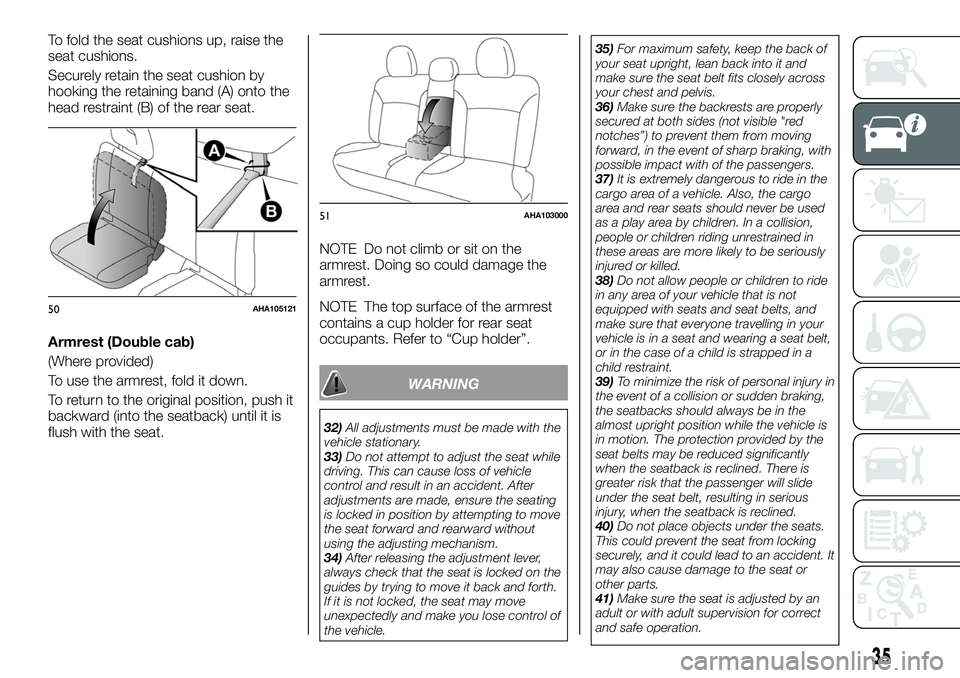
To fold the seat cushions up, raise the
seat cushions.
Securely retain the seat cushion by
hooking the retaining band (A) onto the
head restraint (B) of the rear seat.
Armrest (Double cab)
(Where provided)
To use the armrest, fold it down.
To return to the original position, push it
backward (into the seatback) until it is
flush with the seat.NOTE Do not climb or sit on the
armrest. Doing so could damage the
armrest.
NOTE The top surface of the armrest
contains a cup holder for rear seat
occupants. Refer to “Cup holder”.
WARNING
32)All adjustments must be made with the
vehicle stationary.
33)Do not attempt to adjust the seat while
driving. This can cause loss of vehicle
control and result in an accident. After
adjustments are made, ensure the seating
is locked in position by attempting to move
the seat forward and rearward without
using the adjusting mechanism.
34)After releasing the adjustment lever,
always check that the seat is locked on the
guides by trying to move it back and forth.
If it is not locked, the seat may move
unexpectedly and make you lose control of
the vehicle.35)For maximum safety, keep the back of
your seat upright, lean back into it and
make sure the seat belt fits closely across
your chest and pelvis.
36)Make sure the backrests are properly
secured at both sides (not visible "red
notches”) to prevent them from moving
forward, in the event of sharp braking, with
possible impact with of the passengers.
37)It is extremely dangerous to ride in the
cargo area of a vehicle. Also, the cargo
area and rear seats should never be used
as a play area by children. In a collision,
people or children riding unrestrained in
these areas are more likely to be seriously
injured or killed.
38)Do not allow people or children to ride
in any area of your vehicle that is not
equipped with seats and seat belts, and
make sure that everyone travelling in your
vehicle is in a seat and wearing a seat belt,
or in the case of a child is strapped in a
child restraint.
39)To minimize the risk of personal injury in
the event of a collision or sudden braking,
the seatbacks should always be in the
almost upright position while the vehicle is
in motion. The protection provided by the
seat belts may be reduced significantly
when the seatback is reclined. There is
greater risk that the passenger will slide
under the seat belt, resulting in serious
injury, when the seatback is reclined.
40)Do not place objects under the seats.
This could prevent the seat from locking
securely, and it could lead to an accident. It
may also cause damage to the seat or
other parts.
41)Make sure the seat is adjusted by an
adult or with adult supervision for correct
and safe operation.
50AHA105121
51AHA103000
35
Page 40 of 316
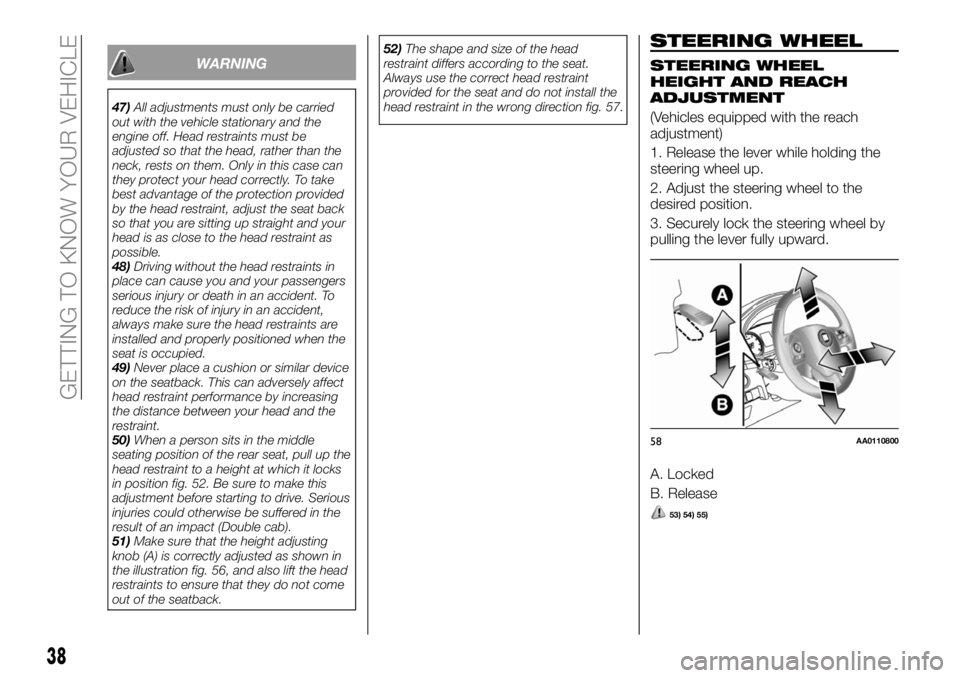
WARNING
47)All adjustments must only be carried
out with the vehicle stationary and the
engine off. Head restraints must be
adjusted so that the head, rather than the
neck, rests on them. Only in this case can
they protect your head correctly. To take
best advantage of the protection provided
by the head restraint, adjust the seat back
so that you are sitting up straight and your
head is as close to the head restraint as
possible.
48)Driving without the head restraints in
place can cause you and your passengers
serious injury or death in an accident. To
reduce the risk of injury in an accident,
always make sure the head restraints are
installed and properly positioned when the
seat is occupied.
49)Never place a cushion or similar device
on the seatback. This can adversely affect
head restraint performance by increasing
the distance between your head and the
restraint.
50)When a person sits in the middle
seating position of the rear seat, pull up the
head restraint to a height at which it locks
in position fig. 52. Be sure to make this
adjustment before starting to drive. Serious
injuries could otherwise be suffered in the
result of an impact (Double cab).
51)Make sure that the height adjusting
knob (A) is correctly adjusted as shown in
the illustration fig. 56, and also lift the head
restraints to ensure that they do not come
out of the seatback.52)The shape and size of the head
restraint differs according to the seat.
Always use the correct head restraint
provided for the seat and do not install the
head restraint in the wrong direction fig. 57.
STEERING WHEEL
STEERING WHEEL
HEIGHT AND REACH
ADJUSTMENT
(Vehicles equipped with the reach
adjustment)
1. Release the lever while holding the
steering wheel up.
2. Adjust the steering wheel to the
desired position.
3. Securely lock the steering wheel by
pulling the lever fully upward.
A. Locked
B. Release
53) 54) 55)
58AA0110800
38
GETTING TO KNOW YOUR VEHICLE
Page 78 of 316
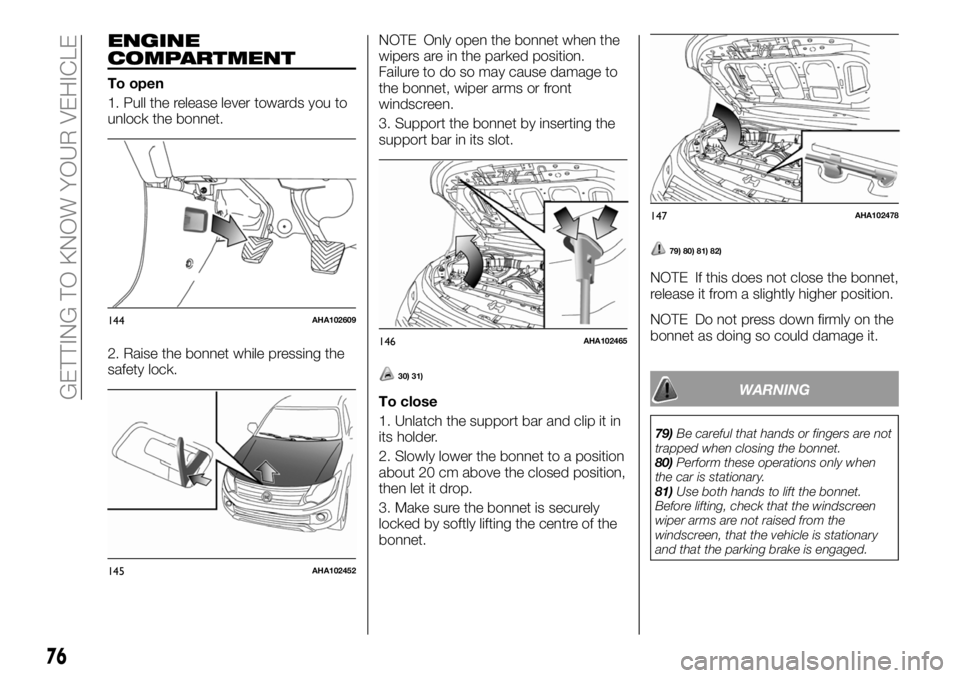
ENGINE
COMPARTMENT
To open
1. Pull the release lever towards you to
unlock the bonnet.
2. Raise the bonnet while pressing the
safety lock.NOTE Only open the bonnet when the
wipers are in the parked position.
Failure to do so may cause damage to
the bonnet, wiper arms or front
windscreen.
3. Support the bonnet by inserting the
support bar in its slot.
30) 31)
To close
1. Unlatch the support bar and clip it in
its holder.
2. Slowly lower the bonnet to a position
about 20 cm above the closed position,
then let it drop.
3. Make sure the bonnet is securely
locked by softly lifting the centre of the
bonnet.
79) 80) 81) 82)
NOTE If this does not close the bonnet,
release it from a slightly higher position.
NOTE Do not press down firmly on the
bonnet as doing so could damage it.
WARNING
79)Be careful that hands or fingers are not
trapped when closing the bonnet.
80)Perform these operations only when
the car is stationary.
81)Use both hands to lift the bonnet.
Before lifting, check that the windscreen
wiper arms are not raised from the
windscreen, that the vehicle is stationary
and that the parking brake is engaged.
144AHA102609
145AHA102452
146AHA102465
147AHA102478
76
GETTING TO KNOW YOUR VEHICLE
Page 79 of 316

82)For safety reasons, the bonnet must
always be properly closed while the car is
travelling. Therefore, make sure that the
bonnet is properly closed and that the lock
is engaged. If you discover that the bonnet
is not perfectly closed during travel, stop
immediately and close the bonnet in the
correct manner.
IMPORTANT
30)Note that the support bar may
disengage the bonnet if the open bonnet is
lifted by a strong wind.
31)After inserting the support bar into the
slot, make sure the bar supports the
bonnet securely from falling down on to
your head or body.
CARGO AREA
CARGO LOADS
83) 84)
Cargo loads precautions
When loading luggage, be careful to the
following.
Stow cargo and luggage in the cargo
area whenever possible.
Distribute cargo or luggage evenly so
that it is not unbalanced.
Do not place cargo or luggage on
the instrument panel. Also, do not stack
up cargo or luggage on the front
passenger’s seat or the rear seat.
Having the driver’s vision blocked, and
your cargo being thrown inside the
cabin if you suddenly have to brake can
cause a serious accident or injury.
Loading a roof carrier
32) 33)
NOTE We recommend you to use a
FCA GENUINE roof carrier, since the
brackets to be used have a special
shape. For details, we recommend you
to consult an Authorised Fiat
Dealership.
Roof carrier precaution
34) 35)
NOTE To prevent wind noise or
reduction in fuel economy, remove the
roof carrier when not in use.NOTE Remove the roof carrier before
using an automatic car wash.
HIGH-LOAD SYSTEM,
PROTRUDING LOADS
Check that the load is distributed evenly
on the flatbed and that the rear side
panel is correctly closed, so that the
load, or part of it, cannot fall onto the
road surface.
Some simple suggestions can improve
driving safety, comfort and vehicle
duration:
distribute the load evenly over the
platform: if it must be concentrated it in
a single area, choose an area mid-way
between both axles;
remember that the dynamic
behaviour of the vehicle is affected by
the transported weight: in particular, the
stopping distances are longer,
especially at high speed.
Bumpy roads and heavy braking may
cause unexpected load shifting with
consequently hazardous situations:
before setting off, secure the load tightly
using the partition and appropriate
hooks, steel cables, ropes or chains
strong enough to hold the items to be
secured.
83) 84) 85) 86) 87) 88)
77
Page 80 of 316
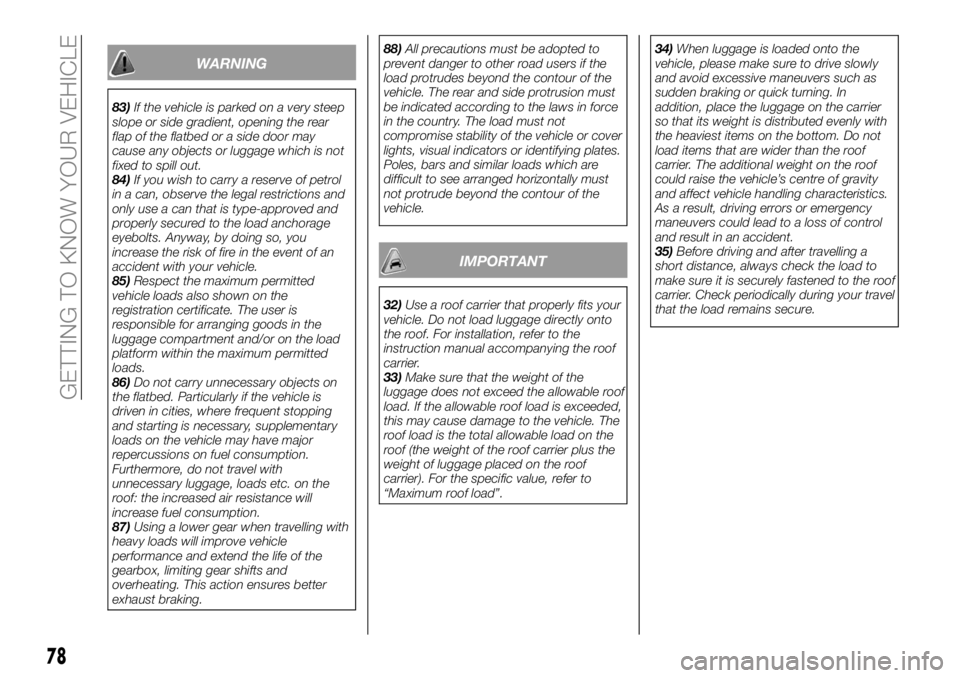
WARNING
83)If the vehicle is parked on a very steep
slope or side gradient, opening the rear
flap of the flatbed or a side door may
cause any objects or luggage which is not
fixed to spill out.
84)If you wish to carry a reserve of petrol
in a can, observe the legal restrictions and
only use a can that is type-approved and
properly secured to the load anchorage
eyebolts. Anyway, by doing so, you
increase the risk of fire in the event of an
accident with your vehicle.
85)Respect the maximum permitted
vehicle loads also shown on the
registration certificate. The user is
responsible for arranging goods in the
luggage compartment and/or on the load
platform within the maximum permitted
loads.
86)Do not carry unnecessary objects on
the flatbed. Particularly if the vehicle is
driven in cities, where frequent stopping
and starting is necessary, supplementary
loads on the vehicle may have major
repercussions on fuel consumption.
Furthermore, do not travel with
unnecessary luggage, loads etc. on the
roof: the increased air resistance will
increase fuel consumption.
87)Using a lower gear when travelling with
heavy loads will improve vehicle
performance and extend the life of the
gearbox, limiting gear shifts and
overheating. This action ensures better
exhaust braking.88)All precautions must be adopted to
prevent danger to other road users if the
load protrudes beyond the contour of the
vehicle. The rear and side protrusion must
be indicated according to the laws in force
in the country. The load must not
compromise stability of the vehicle or cover
lights, visual indicators or identifying plates.
Poles, bars and similar loads which are
difficult to see arranged horizontally must
not protrude beyond the contour of the
vehicle.
IMPORTANT
32)Use a roof carrier that properly fits your
vehicle. Do not load luggage directly onto
the roof. For installation, refer to the
instruction manual accompanying the roof
carrier.
33)Make sure that the weight of the
luggage does not exceed the allowable roof
load. If the allowable roof load is exceeded,
this may cause damage to the vehicle. The
roof load is the total allowable load on the
roof (the weight of the roof carrier plus the
weight of luggage placed on the roof
carrier). For the specific value, refer to
“Maximum roof load”.34)When luggage is loaded onto the
vehicle, please make sure to drive slowly
and avoid excessive maneuvers such as
sudden braking or quick turning. In
addition, place the luggage on the carrier
so that its weight is distributed evenly with
the heaviest items on the bottom. Do not
load items that are wider than the roof
carrier. The additional weight on the roof
could raise the vehicle’s centre of gravity
and affect vehicle handling characteristics.
As a result, driving errors or emergency
maneuvers could lead to a loss of control
and result in an accident.
35)Before driving and after travelling a
short distance, always check the load to
make sure it is securely fastened to the roof
carrier. Check periodically during your travel
that the load remains secure.
78
GETTING TO KNOW YOUR VEHICLE